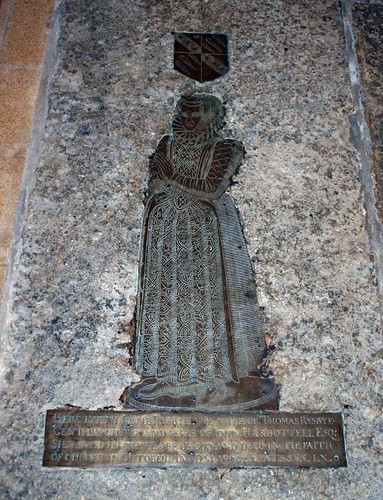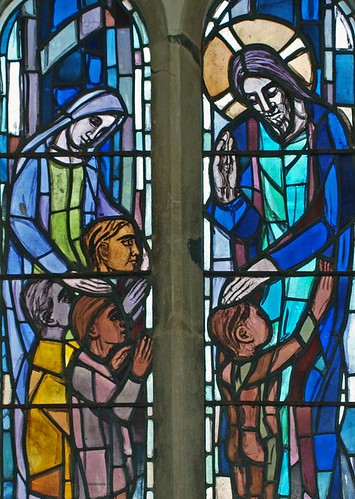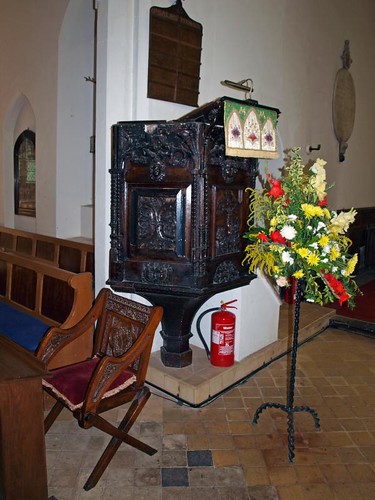ST LAWRENCE. C13 W tower, see the lancet openings with later diagonal buttresses. C13 chancel see the double piscina with dogtooth decoration. C13 nave, see the renewed paired lancet windows. C19 transepts. The whole exterior unfortunately cemented. - FONT. Octagonal, of Purbeck marble, C13, with two shallow blank pointed arches on each side of the bowl. - PULPIT. Made up of odd pieces, C16 and C17, one being a relief of the Crucifixion. - HELM. C16, in the chancel. - PLATE. C17 Cup. - MONUMENTS. Brass to Joane Risbye d. 1598, the figure about three feet tall. - Elizabeth Agassiz, by Chantrey, undated, with kneeling, mourning female figure.
BRADFIELD. The dormer windows of its thatched cottages have peeps of the River Stour as it pours itself into the sea. For 600 years and more a bell in the tower has been summoning the people of the cottages to the 13th century church, ringing out its merry message, “I am cock of this flock.” The bell is centuries older than the tower, which was set up in the 16th century, its cheerful builders giving each of its four faces a row of seven jovial heads.
St George in brilliant enamel greets us as we come through the 14th century doorway, and a glowing transept window tells the story of the first Easter morning. The 18th century pulpit has earlier carving fixed on it. In the chancel is the portrait in brass of Joan Rysbye, shown in the grand dress she wore in the days of the Armada; and there is a brass tablet to Elizabeth Grimstone, who lived at the handsome moated house a mile away, Bradfield Hall. One of its wings is 400 years old. Here was born Sir Harbottle Grimstone, who tried the judges who tried the King. Born under Queen Elizabeth, he lived through the dramatic reigns of the Stuarts to within a few years of the flight of the last of them. In Parliament he stoutly championed popular rights, helped to frame the Grand Remonstrance to impeach Archbishop Laud, and to vindicate the privileges of the House when Charles sought to arrest the Five Members. He knelt to Charles, imploring him to make peace with his people, and when that failed he left the country after the execution of the king, remaining abroad for several years. Returning to Parliament, he was elected Speaker in 1660 and was sent to Holland to recall Charles the Second, to whom he delivered the official speech of welcome in Parliament. A kindly, hospitable man, charitable to the poor, and tolerant in religion, he sleeps in St Michael’s Church, St Albans.
Simon K -
You enter through a modern extension, very reminiscent of Whittlesford
in Cambridgeshire. The church is full of light and full of delights,
excellent windows by Rosemary Rutherford, Edward Burne-Jones and John
Hardman. Full of interest, and in a joint parish with Mistley, which
is also open every day, of course.
I need to go back because I messed up the exteriors, thinking I had autofocus locked on when I hadn't, but on this occasion I pumped up my rapidly deflating rear tyre and limped back to Manningtree station, past the towers of John Nash's lost Mistley church, and was home in time for tea.
Flickr.
St George in brilliant enamel greets us as we come through the 14th century doorway, and a glowing transept window tells the story of the first Easter morning. The 18th century pulpit has earlier carving fixed on it. In the chancel is the portrait in brass of Joan Rysbye, shown in the grand dress she wore in the days of the Armada; and there is a brass tablet to Elizabeth Grimstone, who lived at the handsome moated house a mile away, Bradfield Hall. One of its wings is 400 years old. Here was born Sir Harbottle Grimstone, who tried the judges who tried the King. Born under Queen Elizabeth, he lived through the dramatic reigns of the Stuarts to within a few years of the flight of the last of them. In Parliament he stoutly championed popular rights, helped to frame the Grand Remonstrance to impeach Archbishop Laud, and to vindicate the privileges of the House when Charles sought to arrest the Five Members. He knelt to Charles, imploring him to make peace with his people, and when that failed he left the country after the execution of the king, remaining abroad for several years. Returning to Parliament, he was elected Speaker in 1660 and was sent to Holland to recall Charles the Second, to whom he delivered the official speech of welcome in Parliament. A kindly, hospitable man, charitable to the poor, and tolerant in religion, he sleeps in St Michael’s Church, St Albans.
Simon K -
Open. This church is always open in daylight hours. The best church of the day. A big cruciform church with a western
tower, looking ruggedly Norman but probably rebuilt in the 14th
century.
I need to go back because I messed up the exteriors, thinking I had autofocus locked on when I hadn't, but on this occasion I pumped up my rapidly deflating rear tyre and limped back to Manningtree station, past the towers of John Nash's lost Mistley church, and was home in time for tea.
Flickr.



No comments:
Post a Comment